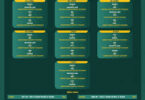David Vergun
Sports Heroes Who Served is a series that highlights the accomplishments of athletes who served in the U.S. military.
Eddie Rickenbacker was a champion race car driver. He was also an aircraft fighter ace in World War I, who was awarded the Medal of Honor, seven Distinguished Service Cross medals and the French Croix de Guerre.
Rickenbacker was born in Columbus, Ohio, in 1890. He raced four times in the Indianapolis 500 and finished 10th in 1914, his best. He also raced in the American Grand Prize in San Francisco in 1915 and in many other races.
A month after the U.S. entered World War I in April 1917, Rickenbacker enlisted in the Army, and by May 1917, he was driving high ranking military officers around in France.
Spotlight: Commemorating World War I
In September 1917, he received five weeks of flight training at a French flight school near Toul, and on April 29, 1918, he shot down his first enemy plane. By May 28, 1918, Rickenbacker had shot down a total of five German planes, thereby making him an ace. Just two days later on May 30, he shot down his sixth enemy plane.
By September 1918, Rickenbacker, now an Army Air Service captain, commanded the 94th Aero Squadron.
By the end of the war, Rickenbacker had shot down 27 enemy planes, making him the number one American ace of the war. He also shot down five enemy observation balloons.
In 1919, he was honorably discharged from the Army with the rank of major. He died in 1973 at the age of 82.
Here are just a few of the many post-World War I highlights of this extraordinary man’s life:
Invented a tandem flywheel attached to each end of the crankshaft to reduce vibration in a car that he designed called the Rickenbacker. The car was sold from 1922 to 1926.
In 1927, he bought the Indianapolis Motor Speedway, which he operated for the next 14 years.
In January 1928, Rickenbacker became assistant general manager for sales at GM for its Cadillac and LaSalle models.
Denounced President Franklin D. Roosevelt’s New Deal policies as similar to socialism.
Became owner of Eastern Air Lines in 1938 and ran the company until 1959.
As a passenger, he was severely injured in an Eastern Air Lines Douglas DC-3 airliner crash near Atlanta, Georgia, Feb. 26, 1941. Despite his injuries, he helped others to safety. The press printed his obituary, but he managed to pull through after many months in the hospital.
Before America entered World War II, he threw his support to the United Kingdom, which was at war with Germany beginning in 1939. He directed Eastern Air Lines to fly munitions and supplies to the U.K.
After America’s entry into World War II, Rickenbacker, as a civilian, continued his wartime support, flying on military missions in the Pacific. In October 1942, as a crew member, his B-17D Flying Fortress aircraft developed problems and ditched in the Central Pacific. For 24 days, Rickenbacker and the crew drifted in life rafts until most were rescued.
In 1943, he flew to China, India and the Soviet Union on a wartime fact finding mission. He shared his intelligence with British Prime Minister Winston Churchill and the U.S. War Department. For his wartime efforts as a civilian, the U.S. president awarded him the Medal for Merit.






